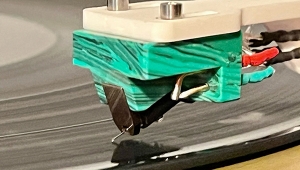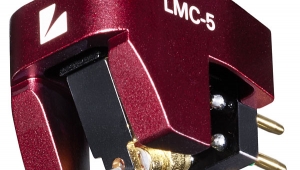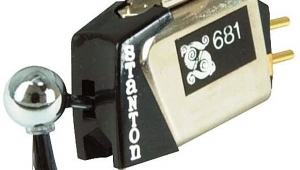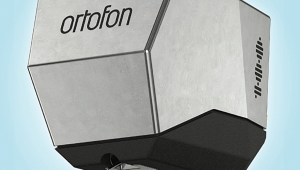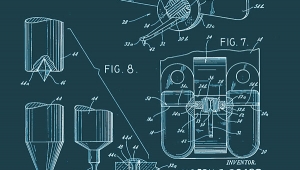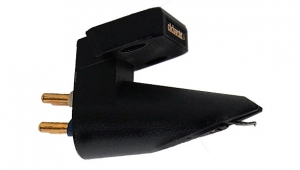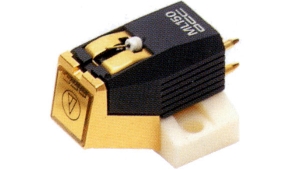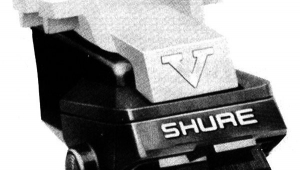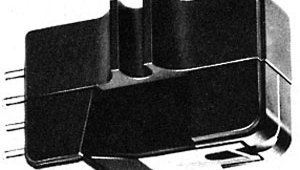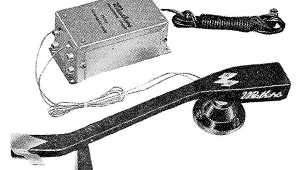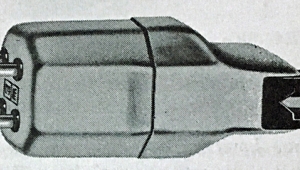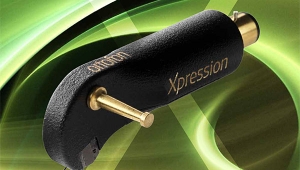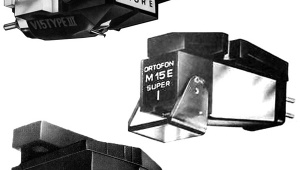| Columns Retired Columns & Blogs |
Linn Arkiv B phono cartridge Page 2
Getting the bottom end right
I suspect I've remained loyal to Linn cartridges over the years because I've always found them superior to the competition through the bass region. For me, at least, music builds from the foundation of the bass, and getting the bottom end as tight and coherent as possible is more important than worrying about the midband and top end. Linn's three-point headshell mount undoubtedly helps, and is one advantage that Linn holds over other high-end rivals. (To my knowledge, only Rega has emulated this, in a moving-magnet design.)
I suspect I've remained loyal to Linn cartridges over the years because I've always found them superior to the competition through the bass region. For me, at least, music builds from the foundation of the bass, and getting the bottom end as tight and coherent as possible is more important than worrying about the midband and top end. Linn's three-point headshell mount undoubtedly helps, and is one advantage that Linn holds over other high-end rivals. (To my knowledge, only Rega has emulated this, in a moving-magnet design.)
When I changed from the Arkiv to the Arkiv B, my first surprise was that the new cartridge worked superbly straight from the box—its predecessor hadn't sounded this good for at least a week. Exactly the same was true for my second sample of the Arkiv B: no run-in, no messin,' instant gratification!
Gratification was very much on the agenda. The new cantilever material cleaned up the top end of the spectrum to a remarkable degree. More information and detail came through from deeper down in the mix, stereo precision and focus improved markedly, and less accessible material and recordings became more listenable. Best of all was a quite dramatic reduction in the general level of high-frequency hash or grunge, which seemed to increase the subjective dynamic range by several dB.
The end result was a sound that had all the musical virtues of the vinyl disc—transparency, delicacy, naturalness, etc.—alongside a presentation that was quite un-vinyl-like in its freedom from spurious noise. With hindsight, I suspect that some preferred the Troika to the original Arkiv because the latter's more forward and open balance made its cantilever/rotor limitations that much more obvious. In a sense, the Troika was better balanced in that respect. The revisions made for the Arkiv B have created a design that is altogether better balanced overall.
A few months after first installing the Arkiv B, I was commissioned to review a group of eight other high-end cartridges, most of them more expensive than the Linn. The Arkiv B stacked up very well in this context: Its top end was arguably the most smooth and least resonant of all, especially on the critical crosstalk traces, while under my conditions, only the Clearaudio Signature rivaled it.
The one weak spot I encountered was that old bugbear, trackability, and even that didn't prove a serious problem. The Arkiv B has a lower (ie, stiffer) compliance than average, placing the fundamental tonarm/compliance resonance at a highish 14-15Hz when mounted in the medium-mass Naim ARO arm. Significantly, that resonance is more heavily damped than average with MC cartridges, meaning that this combination is very good at suppressing subsonic intermodulation, and gives very good macro-groove stability. However, it can be caught out by the odd hot cut.
There are just two discs in my collection that the Arkiv B couldn't track within its recommended 1.8-2.0gm tracking-force range, and neither is anything like typical vinyl fare: Leftfield's "Inspection (Check One)" (from Leftism, Hard Hands CK 67231), and KLF's "It's Grim Up North" (a 12" single from 1991, long since out of print) are both extreme techno/dance tracks, and are among my favorite subwoofer test records. But nothing else I tried tripped up the Arkiv B. It sailed happily through Verdi's Otello (Karajan, EMI SLS 975), for example.
There seems to be a trend today toward removing the bodywork from high-end cartridges, accepting extra vulnerability in the quest for lower coloration, and there is a tempting-looking screw on the side of the Arkiv B. I put the question to Linn's Martin Dalgleish, who said, in Glaswegian: "I dusny change any'hing." I had to try for myself, of course, but he was quite right: The body stays on (and the boron cantilever breathes a sigh of relief).
Archiving the Arkiv
The hardest question to answer is "How does it sound?" The Arkiv B proved very neutral, with a wide dynamic range that revealed remarkably little of its own sonic signature. It therefore tended to sound like whatever tonearm or turntable I used it with, or even (if you're lucky) the recording studio in which a particular record was made. I used it in the Linn Ekos and Naim ARO arms, both of which have the preferred but not essential third fixing hole; on Linn Sondek LP12 'tables with Lingo and Armageddon power supplies; and with Linto and Prefix phono preamplifiers. I also tried an ARO-equipped Rega Planar 9. In every case, the characters of the various ancillaries came through very clearly.
The Arkiv B certainly didn't sound "romantic" or "euphonic"; in fact, some might find it a little too dry and clinical. There was no excess warmth through the bass, no obvious fizz or sparkle in the treble. I'd even describe it as "un-vinyl-like." Today's "full Monty" Linn record player has a subjective balance that's surprisingly close to CD in its neutrality—yet still, to these ears, comfortably wins with its naturalness and freedom from listening fatigue. Though auditioned many months apart, my two review samples of the Arkiv B sounded very similar—an encouraging sign.
The only downside of joining the high-end vinyl club is the running costs, which in my case roughly equal my car-insurance premiums. The upside was how the Arkiv B managed to upgrade my entire LP collection overnight, making even musically difficult material that much more accessible.
I think I'll just go give the Beastie Boys' "Hello Nasty" a quick spin.
- Log in or register to post comments
